Animal Science
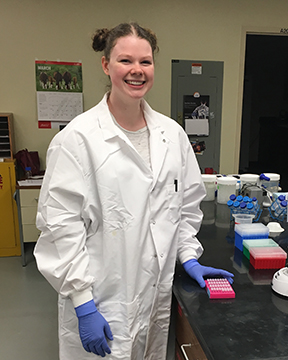
Alexa Kapla
Faculty Mentor: Dr. Jessica Petersen
Investigating the Genetic Basis of White Markings in Horses
The coloring and markings of horses have long been of interest. While basic coat color heredity has been resolved, the inheritance and distribution of white markings are not well understood. Handful of genes have been linked to the inheritance of white markings in horses and other mammals in the past decade, including KIT, MITF, and PAX3; however, the role of each gene and their interactions with each other remains unknown. The goal of this project is to identify which pigmentation genes contribute to specific white markings in Clydesdales, including white markings on the face, legs, and body, as well as “roan” coloring. The goal of identifying related pigmentation genes will be achieved by performing phenotyping, SNP genotyping, and whole-genome sequencing.

Heather Hunt
Faculty Mentor: Dr. Gary Sullivan
Development of guidelines to ensure the safety of sous vide cooked beef steaks
Sous vide cooking can be used to achieve a precise temperature and doneness throughout steaks–allowing for a more uniform eating quality. There has been an increase in popularity of sous vide cooking among restaurants and homes alike, but cooking guidelines are lacking. The biggest concern is insufficient pathogen control. This problem arises from the meat not being cooked and held at the proper temperatures to kill pathogens. In this project, 1-inch steaks will be sampled and enumerated for E. coli at various cooking times and temperatures. The goal of the project is to address food safety concerns associated with online sous vide cooking recommendations.
Biochemistry
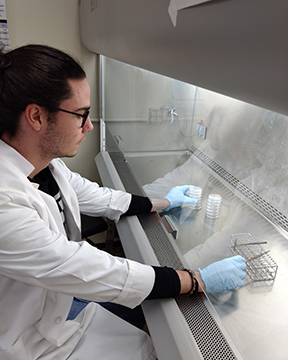
Cristian Wulkop Gil
Faculty Mentor: Dr. Sydney Everhart
Fungicide Sensitivity of Sclerotinia sclerotiorum Isolates Selected from Five States That Use Different Fungicide Treatments
The goal of my project is to assess the extent of fungicide sensitivity in S. sclerotiorum isolates selected from dry bean fields in five states that use different fungicide treatments. I hypothesize that the isolates from different states should have different sensitivities depending on how aggressive their previous fungicide treatment has been. In my study, the isolates are going to be treated with four fungicides at a discriminatory concentration previously determined by members of the Everhart lab. I will measure the growth of the isolates to calculate the percent growth and to determine the EC50(D). The data from the isolates from different States will be compared. Results from my study will also be compared with isolates gathered from soybean fields.
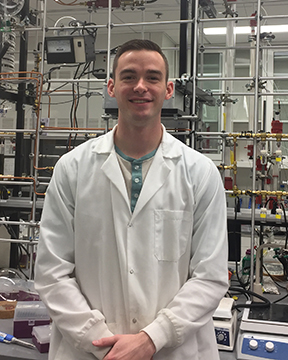
Spencer Jones
Faculty Mentor: Dr. Limei Zhang
The Effects of Iron-Sulfur Clusters on Fluorescent Markers in Mycobacterium tuberculosis
Tuberculosis is extremely difficult to treat when compared to other bacterial pathogens. Through the acquired antibiotic resistance of some strains of Mtb, the resulting tuberculosis can be even more devastating. One group of the organismal proteins in particular, the WhiB family, has shown to be vital to several key aspects of Mtb growth and virulence. Of the WhiB proteins, WhiB1 has been shown to pertain specifically to Mtb’s growth and reproduction. This research will focus on both identifying an effective fluorescent tag for studying in vivo WhiB1 levels and characterizing 4Fe-4S cluster interactions in GFP and mCherry. A more thorough understanding of both topics will result in more accurate research on WhiB1 which could lead to potential breakthroughs in tuberculosis treatment strategies.
Biological Systems Engineering

Eric Henning
Faculty Mentor: Dr. Amy Schmid
Carbon and Nitrogen Dynamics in Manure and Cedar Mulch Amended Soil
To address the issues of manure underutilization and cedar tree encroachment in Nebraska, this study will analyze the effects of amending soil with manure and cedar mulch. Through a series of laboratory and field experiments, this research will answer three questions: 1) To what degree is nitrogen mineralized and/or immobilized in soils following application of these amendments? 2) How quickly doescarbon in cedar wood chips and livestock manure decompose and how much carbon is mineralized to carbon dioxide, a greenhouse gas? And, 3) How much carbon is sequestered in soils as these materials decompose? These processes affect the agronomic value of these amendments and potential contributions to climate change, and will assist producers in developing a plan for how often to apply mulch.
Entomology

Earl Agpawa
Faculty Mentor: Dr. Joe Louis
Characterization of Tolerance Mechanism in Nested Association Mapping Population Against Sugarcane Aphids, Melanaphis sacchari
In this project I will be conducting experiments to determine how tolerant the sorghum NAM lines are to the sugarcane aphid. The main goal is to determine which sorghum parental NAM line shows the most tolerance and to contribute to better pest management techniques. In order to accomplish this goal, I aim to measure the variables such as weights, heights, and damage ratings on each plant. With the data we may be able to determine the degree of tolerance of each sorghum NAM line in which we could use this data to breed new lines of sorghum which are capable to tolerating aphid and other plant-feeding insect populations.
Environmental Studies

Ryley Thomas
Faculty Mentor: Dr. Michael Kaiser
Remediation strategies to reduce heavy metal uptake in lettuce grown in contaminated community garden soil in Lincoln, NE
This project looks at biochar and spent coffee grounds as remediation strategies for prevention of lead and arsenic uptake by lettuce plants from a contaminated garden soil in Lincoln, NE. High carbon materials, such as these, have the potential to retain lead and arsenic, preventing plant uptake. Both of these heavy metals have been linked to health issues, especially children. We will plant romaine lettuce seeds into contaminated, additive treated, and control soils, and measure the levels of lead and arsenic in the stems, roots, leaves, and soil of the plants after 4-6 weeks of growth. Digested samples will be analyzed for heavy metals concentrations with an Inductively Coupled Plasma Mass Spectrometry (ICP-MS), and imaged with Scanning Electron Microscope (SEM-EDX) for location of metal accumulations.
Plant Pathology
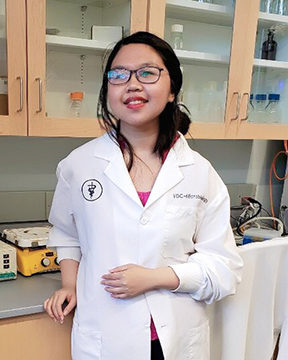
Claudia Antonika
Faculty Mentor: Dr. Hiep Vu
Identification of PRRSV Structural Proteins Capable of Inducing Protective Immunity in Pigs
Porcine Reproductive and Respiratory Syndrome (PRRS) is one of the most devastating viral disease in swine that is caused by PRRS-Virus. Two linages of PRRSV are known as PRRSV-1 (European) and PRRSV-2 (North American). Several types of vaccines have been successfully generated, yet the study of viral infectivity of PRRSV have not been determined. Therefore, in this project, I would like to study the relative contribution of PRRSV proteins particularly structural proteins in inducing swine immunity. Chimeric virus will be created using PRRSV-1 as the backbone and replacing structural proteins of PRRSV-1 with PRRSV-2 structural proteins. To determine viral infectivity, quantitation of viral titer and in vitro immunological assays will be administered. These significant proteins eventually can be used to aid vaccine development research.
College of Agriculture Sciences and Natural Resources
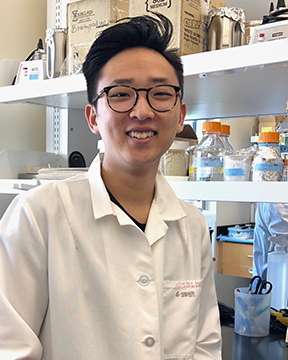
Benjamin Downing
Faculty Mentor: Hernan Garcia-Ruiz
Gene Editing of Arabidopsis thaliana RNA Dependent RNA Polymerases with CRISPR/Cas9
The goal of the project is to use CRISPR/Cas9 to develop A. thaliana mutants with inactivated RDR3 and/or RDR4 genes. After the inactivated mutants are developed, they will be used to grow new sextuple mutants lacking all six RDR genes. This is made possible as the quadruple mutant lacking the remaining RDR genes has previously been developed. Along with the sextuple mutants triple mutants in whom RDR3 and RDR4 are inactive, generated from wild-type and RDR5 inactive mutants, are used as positive and negative controls when testing the sextuple mutant's plant-virus interactions. Meanwhile developing a repeatable protocol for future CRISPR/Cas9 mutational inactivation studies and experiments.
Veterinary and Biomedical Sciences
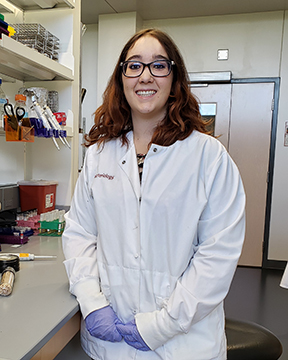
Shalyn Miller
Faculty Mentor: Dr. Dustin Loy
Application and validation of Fourier Transform-Infrared (FT-IR) Spectroscopy method to characterize Moraxella sp. isolated from cattle.
Infectious bovine keratoconjunctivitis (IBK), also called “pinkeye,” causes painful ulcers leading to temporary or permanent blindness. Other effects are significant losses in production, performance, and reduced weight gain and costly treatments. Members of the genus Moraxella are the most frequently isolated bacteria in IBK cases. The goal of this project is to evaluate the use of and validate Fourier transformed infrared spectroscopy (FTIR) as a diagnostic tool to identify Moraxella sp. associated with IBK on a species, subspecies, and sub-cluster level. This research could be used to enhance understanding of this disease, including development of more effective vaccines and optimized selection of strains to include in herd specific vaccines.